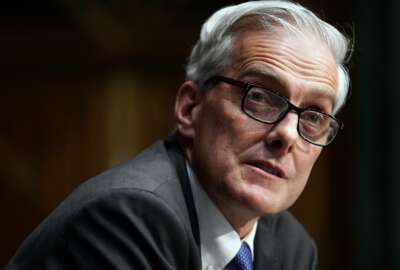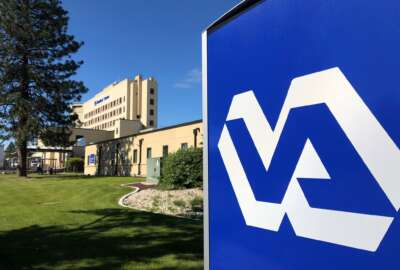

The Department of Veterans Affairs is putting data and emerging technology at the forefront of a modernization agenda that’s ramping up under the PACT Act.
The Department of Veterans Affairs is putting data and emerging technology at the forefront of a modernization agenda that’s ramping up under the PACT Act.
The PACT Act, signed into law last August, is expected to bring an additional 3.5 million veterans, exposed to toxic substances during military service, into VA care. The VA began processing all PACT Act claims at the beginning of January.
Paul Brubaker, the VA’s deputy chief information officer of strategic integration for emerging concepts, said the PACT Act marks the latest in a series of major events — including the COVID-19 pandemic and the MISSION Act — that’s required the VA to step up its delivery of veteran services.
“There’s been a number of inflection points, each driving a higher level of activity in the department, in terms of our digital transformation agenda, and has really accelerated our journey to that digital transformation,” Brubaker said Thursday at AFCEA Bethesda’s Health IT Summit. “It’s really challenged the department to take a look at all the innovation that we’ve introduced in the organization over the last four or five years, and take it to an entirely new level.”
Ryan Vega, chief officer of the Veterans Health Administration’s Office of Health Care Innovation and Learning, said the VA is modernizing its IT infrastructure to allow greater collaboration with industry and accelerate the pace of innovation.
“If we don’t build for the future, we’ll be obsolete,” Vega said.
The VA, among its goals, is looking to make better use of the data it and partner agencies already have, to handle a major expansion of VA health care and benefits.
Carrie Lee, acting executive director of product engineering, said the VA is breaking down some of the barriers between VHA and the Veterans Benefits Administration to get a “360 view” of a veteran’s experience with the agency.
“Traditionally, the benefits data has always been separate from the health data. Now we’re pulling it all together, to really follow that veteran and be able to support that veteran and whatever needs that veteran has. Delivering those insights is one of the key enablers of the VA mission and our ability to serve veterans where they are,” Lee said.
Lee said the PACT Act’s expansion of benefits and health care requires the VA to adopt the latest technology more quickly, in order to serve a growing population of patients and beneficiaries.
The VA, through data sharing with the Defense Department, is getting a better understanding of the upcoming veteran population, and where they’ll live once they leave military service.
“We’re getting all that data from DoD. We’re synthesizing it, we’re running our analytics, and it allows us to understand which veterans are eligible [for PACT Act benefits],” Lee said. “It allows us to understand how do we staff our hospitals. Where do [veterans] live now? Where are we going to see the most traffic? Those are some great things we’re doing around modernization and transformation to support the PACT Act,” Lee said.
That military service data will also help the VA understand the future veteran population as the agency prepares a new infrastructure plan for its health care facilities nationwide.
Vega said VA’s clinicians under the PACT Act are focused on ramping up screening, diagnosis and treatment of veterans exposed to toxic substances during their military service.
To handle this increased workload, the VA is rolling out several new platforms with automation and artificial intelligence tools to augment its outreach to veterans and allow VA’s workforce to better serve veterans.
“Part of that requires us having a better digital platform, a better digital experience — the ability to push a simple text message out to a veteran say, ‘Where did you serve? Was it here? There’s a potential that you were exposed,’ and then we can combine that geospatial data and make it easy for them, and tell them, ‘Hey, you were probably exposed, come at this date to get screening,’” Vega said.
The VA under the PACT Act is looking at tech tools to screen millions of veterans for possible toxic exposure more quickly. The VA recently completed more than a million toxic exposure screenings and continues to reach out to veterans who may be eligible for PACT Act care and benefits.
Lee said the VA is launching a benefits platform that will notify veterans when they qualify for benefits, and help them apply.
“As soon as a veteran becomes eligible, we can notify that veteran you’re eligible. We can pre-fill claim forms for them. All they have to do is click a button. The dream is really to be able to really be able to serve veterans through automation,” she said.
Lee said the VA is also using machine learning to identify at-risk veterans in need of care, and connect them with providers.
“We can reach out to their providers and their caregivers and clinical support for those at-risk veterans. It really changes the paradigm, so we’re not waiting for a veteran to call us, but we actually can reach out to them, and maybe save them,” she said.
To improve the treatment of veterans, the VA is also rolling out a health data analytics platform, and using the platform to test use cases where emerging technology can improve health care.
Vega said that, for example, evidence shows AI algorithms, after viewing millions of chest X-rays and CT scans, can help augment a radiologist’s ability to detect and diagnose conditions.
“What it can detect is slight changes or variations in those pixels that the human eye can’t see,” Vega said. “We’ve handled the screening front. Now we can use these tools to improve and enhance our ability to diagnose. And then in the future, that precision component will give us the ability to better treat [veterans].”
VA officials said the agency has come a long way in the past few years to improving coordination and cooperation across its operations.
Vega said the VA’s cloud environment in AWS and Azure allows VA researchers and clinicians to run models and testing, and gain access to large sets of data. He said the cloud environment also provides greater visibility into the agency’s research and development.
“We actually now look at projects as they’re moving through the lifecycle together, and can better understand, does this or should this be something that’s scaled in production? It’s not me telling IT or IT saying ‘no.’ It’s actually us working collaboratively to move projects into production at scale,” Vega said.
That cloud infrastructure, he added, has led to greater coordination across the agency.
“You would think that putting those layers would just be more bureaucracy, but instead of it being just us at each other — ‘No, you can’t do this,’ and ‘Well, I need to do this — it’s a lot tighter collaboration, because it’s happening at the onset. And I think we’re seeing products, and there’s a few that come to mind, that have actually scaled across the enterprise much more timely,” Vega said.
Don Carter, VA’s Director of IT Acquisition Strategy and Vendor Management Office, said the VA has shown improvement in coordinating its IT acquisitions agencywide since Congress passed the Federal Information Technology Acquisition Reform Act (FITARA) more than eight years ago.
“We’ve gotten a lot better where we can coordinate this organization. And that also helps us when we look at what our customers need, and also when we look at the vendors. So if a vendor comes in, they have a specific product … we reach out to our partners in VHA, and VBA – ‘We have this person coming in. Would you like to listen, to see what we have?'” Carter said.
IT modernization efforts at VA have also benefited other parts of the federal government. The VA, through its FedRAMP authorization program, has approved about 80 systems over the past three years, making VA a leader among agencies sponsoring cloud providers seeking FedRAMP approval.
“Once a system has FedRAMP authorization, then other federal agencies can use it. And some federal agencies are small and don’t have that capability to sponsor a system. So we really open up the doors for other agencies to use cloud — agencies that aren’t as big as VA,” Lee said.
Copyright © 2025 Federal News Network. All rights reserved. This website is not intended for users located within the European Economic Area.
Jory Heckman is a reporter at Federal News Network covering U.S. Postal Service, IRS, big data and technology issues.
Follow @jheckmanWFED



